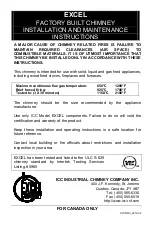
Page 21
Gas Piping
In the U.S. and Canada, both flexible and rigid gas pipe
are approved for use with these appliances. Consult local
codes for gas piping practices.
1 - Lennox gas fireplaces are shipped standard for left
or right side or bottom installation of gas piping. Sim-
ply connect gas supply to gas valve. Gas valve con-
nection is 3/8 in.
2 - When connecting gas supply, factors such as length
of run, number of fittings and furnace rating (if appli-
cable) must be considered to avoid excessive pres-
sure drop.
3 - Gas piping must not run in or through air ducts,
clothes chutes, chimneys or gas vents, dumb waiters
or elevator shafts.
4 - Piping should be sloped 1/4 inch per 15 feet upward to-
ward the meter from the appliance. The piping must be
supported at proper intervals (every 8 to 10 feet) using
suitable hangers or straps.
5 - In some localities, codes may require installation of
an equipment shut-off valve and union (both fur-
nished by installer) external to the unit. Union must
be of the ground joint type. See figure 32.
IMPORTANT
Compounds used on threaded joints of gas piping
must be resistant to the actions of liquified petroleum
gases.
NOTE - In case emergency shutoff is required, close equip-
ment shut-off valve and disconnect main power to unit.
These devices should be properly labeled by the installer.
The appliance must be isolated from the gas supply sys-
tem by closing its equipment shut-off valve during any
pressure testing of the gas supply piping system at test
pressures equal to or less than 1/2 psig (3.48 kPa).
The appliance and its appliance main gas valve must be
disconnected from the gas supply piping system during
any pressure testing of the gas supply system at test pres-
sures in excess of 1/2 psig (3.48 kPa). See figure 32.
LEAK CHECK
After gas piping is completed, carefully check all piping
connections (factory and field) for gas leaks. Use a leak
detecting solution or other preferred means.
CAUTION
Some soaps used for leak detection are corrosive
to certain metals. Carefully rinse piping thoroughly
after leak test has been completed. Do not use
matches, candles, flame or other sources of igni-
tion to check for gas leaks.
IMPORTANT
Appliance gas valves can be damaged if subjected
to more than 1/2 psig (3.48 kPa) pressure. There-
fore, when pressure testing the gas supply piping
system in this pressure range, the appliance gas
valve must be disconnected and isolated.
ISOLATE APPLIANCE
MAIN GAS VALVE DURING
TESTING
CAP
GROUND
JOINT
UNION
DRIP LEG
EQUIPMENT
SHUT-OFF VALVE
Equipment shut-off
valve will not hold test
pressures greater than
1/2 psig (3.48kPa).
GAS SUPPLY PIPING SYSTEM
APPLIANCE
FIGURE 32
Unit Start-up
FOR YOUR SAFETY READ BEFORE LIGHTING
WARNING
Do not use this appliance if any part has been
underwater. Immediately call a qualified service
technician to inspect the fireplace and to replace
any part of the control system and any gas control
which has been under water.
WARNING
If overheating occurs or if gas supply fails to shut
off, close the manual shut-off valve to the appliance
before shutting off electrical supply.
CAUTION
Before attempting to perform any service or
maintenance, turn the electrical power to ap-
pliance OFF at disconnect switch.
WARNING
Do not operate appliance unless glass frame is
properly installed. Glass must not be broken or
cracked.
BEFORE LIGHTING smell all around the appliance area
for gas. Be sure to smell next to the floor because some
gas is heavier than air and will settle on the floor.
Use only your hand to turn the gas control knob. Never use
tools. If the knob will not turn by hand, do not try to repair it,
call a qualified service technician. Force or attempted repair
may result in a fire or explosion.






































